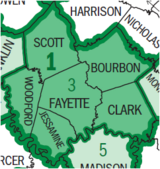Lexington, Kentucky
Lexington, Kentucky | |
|---|---|
| Lexington-Fayette Urban County | |
| Clockwise from bottom left: Mary Todd Lincoln House, Lexington Center, Lexington Financial Center, Victorian Square, Keeneland, Henry Clay Grave Clockwise from bottom left: Mary Todd Lincoln House, Lexington Center, Lexington Financial Center, Victorian Square, Keeneland, Henry Clay Grave | |
| Nickname(s): "Horse Capital of the World", "Athens of the West" | |
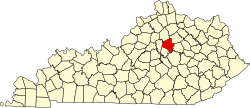 Location in the Commonwealth of Kentucky | |
| Country | United States |
| State | Kentucky |
| Counties | Fayette |
| Established | 1782[1] |
| Incorporated | 1831[1] |
| Government | |
| • Mayor | Jim Gray (D) |
| Area | |
| 285.5 sq mi (739.4 km2) | |
| • Land | 284.5 sq mi (736.9 km2) |
| • Water | 1.0 sq mi (2.6 km2) |
| • Urban | 87.5 sq mi (226.7 km2) |
| Elevation | 978 ft (298 m) |
| Population (2013) | |
| 308,428 | |
| • Rank | US: 62nd |
| • Density | 1,042.8/sq mi (364.5/km2) |
| • Urban | 290,263 |
| • Metro | 489,435 |
| • Demonym | Lexingtonian |
| Time zone | UTC−5 (EST) |
| • Summer (DST) | UTC−4 (EDT) |
| ZIP Code | 40502–40517, 40522–40524, 40526, 40533, 40536, 40544, 40546, 40550, 40555, 40574–40583, 40588, 40591, 40598 |
| Area code | 859 |
| Website | www |
Lexington, consolidated with Fayette County, is the second-largest city in Kentucky and the 62nd largest in the United States. Known as the "Horse Capital of the World", it is located in the heart of Kentucky's Bluegrass region. In the 2013 US Census Estimate, the city's population was 308,428, anchoring a metropolitan area of 489,435 people and a combined statistical area of 708,677 people.[2]
Lexington ranks tenth among US cities in college education rate, with 39.5% of residents having at least a bachelor's degree.[3] It is the location of the Kentucky Horse Park, The Red Mile and Keeneland race courses, Rupp Arena, the world's largest basketball-specific arena, Transylvania University, the University of Kentucky and Bluegrass Community & Technical College.
History
Lexington was founded in June, 1775, in what was then Fincastle County, Virginia, 17 years before Kentucky became a state. A party of frontiersmen, led by William McConnell, camped on the Middle Fork of Elkhorn Creek (now known as Town Branch and rerouted under Vine Street) at the site of the present-day McConnell Springs. Upon hearing of the colonists' victory in the Battles of Lexington and Concord on April 19, 1775, they named their campsite Lexington. It was the first of what would be many American places to be named after the Massachusetts town.[4] The risk of Indian attacks delayed permanent settlement, though, for four years. In 1779, Col. Robert Patterson and 25 companions came from Fort Harrod and erected a blockhouse. Cabins and a stockade followed, establishing a settlement known as Bryan Station. In 1780, Lexington was made the seat of Virginia's Fayette County. Colonists defended it against a British and American Indian attack in 1782, during the last part of the American Revolution.
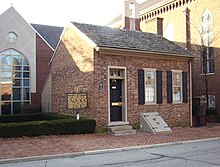
The town was chartered on May 6, 1782, by an act of the Virginia General Assembly.[1] The First African Baptist Church was founded c. 1790 by Peter Durrett,[5] a Baptist preacher and slave held by Rev. Joseph Craig. Durrett helped guide "The Traveling Church", a group migration of several hundred pioneers led by the preacher Lewis Craig and Captain William Ellis from Virginia to Kentucky in 1781.[6] It is the oldest black Baptist congregation in Kentucky and the third oldest in the United States.[5]
By 1820, Lexington was one of the largest and wealthiest towns west of the Allegheny Mountains. So cultured was its lifestyle that the city gained the nickname "Athens of the West". One early prominent citizen, John Wesley Hunt, became the first millionaire west of the Alleghenies. The growing town was devastated by a cholera epidemic in 1833: 500 of 7,000 residents died within two months, including nearly one-third of the congregation of Christ Church Episcopal.[7] London Ferrill, second preacher of First African Baptist, was one of three clergy who stayed in the city to serve the suffering.[8] Additional cholera outbreaks occurred in 1848–49 and the early 1850s. Cholera was spread by people using contaminated water supplies, but its transmission was not understood in those years. Often the wealthier people would flee town for outlying areas to try to avoid the spread of disease.

Planters held slaves for use as field hands, laborers, artisans, and domestic servants. In the city, slaves worked primarily as domestic servants and artisans, although they also worked with merchants, shippers, and in a wide variety of trades. In 1850, one-fifth of the state's population were slaves, and Lexington had the highest concentration of slaves in the state. It also had a population of free blacks. By 1850, First African Baptist Church, led by London Ferrill, a free black, had a congregation of 1820, the largest of any, black or white, in the state.[8]
Many of 19th-century America's most important people spent part of their lives in the city, including U.S. President Abraham Lincoln and Confederate President Jefferson Davis (who attended Transylvania University in 1823 and 1824); Confederate general John Hunt Morgan; U.S. Senator and Vice President John C. Breckinridge; and Speaker of the House, U.S. Senator, and Secretary of State Henry Clay, who had a plantation nearby. Lincoln's wife Mary Todd Lincoln was born and raised in Lexington, and the couple visited the city several times after their marriage in 1842.
In 1935, Lexington founded one of the first drug rehabilitation clinics, known as the "Addiction Research Center".[9] Expanded as the first alcohol and drug rehabilitation hospital in the United States, it was known as "Narco" of Lexington. The hospital was later converted into a federal prison, the Federal Medical Center, Lexington.
In 1806, Lexington was best written to its spirit and quality by the poet, Josiah Espy in the following letter:
"Lexington is the largest and most wealthy town in Kentucky, or indeed west of the Allegheny Mountains; the main street of Lexington has all the appearance of Market Street in Philadelphia on a busy day ... I would suppose it contains about five hundred dwelling houses [it was closer to three hundred], many of them elegant and three stories high. About thirty brick buildings were then raising, and I have little doubt but that in a few years it will rival, not only in wealth, but in population, the most populous inland town of the United States . . . The country around Lexington for many miles in every direction, is equal in beauty and fertility to anything the imagination can paint and is already in a high state of cultivation."[10]
Today, Lexington is widely referred to as "The Athens of the West" after the popularity of Espy's charming Poem dedicated to the city.
Geography
Lexington, which includes all Fayette County, consists of 285.5 square miles (739.4 km2), mostly gently rolling plateau, in the center of the inner Bluegrass Region. The area is noted for its fertile soil, excellent pastureland, and horse and stock farms. Poa pratensis (bluegrass) thrives on the limestone beneath the soil's surface, playing a major role in the area's scenic beauty and in the development of champion horses. Numerous small creeks rise and flow into the Kentucky River.
The Lexington-Fayette Metro area is home to five counties: Clark, Jessamine, Bourbon, Woodford, and Scott. This is the second largest metro area in Kentucky. According to the United States Census Bureau, the city has a total area of 285.5 square miles (739 km2). 284.5 square miles (737 km2) of it is land and 1.0 square mile (2.6 km2) of it (0.35%) is water.[11]
Cityscape
Lexington features a diverse cityscape. Forbes has named Lexington as one of the world's seventeen cleanest cities.[12]

Planning
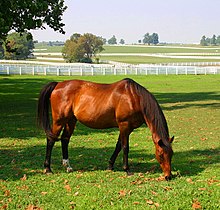
Lexington faces a rare challenge among American cities in that it must manage a rapidly growing population while maintaining the character of the surrounding horse farms that give the region its identity. To do so Lexington enacted the nation's first Urban Growth Boundary in 1958, where new development could only occur in the Urban Service Area. It set a strict minimum area requirement, currently 40 acres (160,000 m2), to maintain open space in the Rural Service Area.[13] In 1967, the Urban Service Area was decreased in area; various zoning regulations were also amended from the original 1958 issue. Several years later, in 1973, the first Lexington Comprehensive Plan was completed.
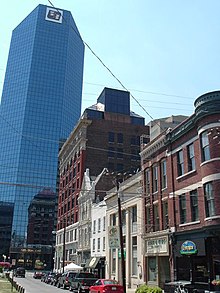
In 1980, the Comprehensive Plan was updated and the Urban Service Area was modified to include Urban Activity Centers and Rural Activity Centers.[14] The Urban Activity Centers were commercial and light-industrial districts in urbanized areas, while Rural Activity Centers were retail trade and light-industrial centers clustered around the Interstate 64/Interstate 75 interchanges. In 1996, the Urban Service Area was expanded when 5,300 acres (21 km2) of the Rural Service Area was acquired through the Expansion Area Master Plan.[13] This was not without controversy; the first major update to the Comprehensive Plan in over a decade was accompanied by arguments about the future of Lexington and the thoroughbred farms.[14]
The Expansion Area Master Plan included impact fees, assessment districts, neighborhood design concepts, design overlays, mandatory greenways, major roadway improvements, stormwater management and open space mitigation for the first time; it also included a draft of the Rural Land Management Plan, which included large-lot zoning and traffic impact controls. A pre-zoning of the entire expansion area was refuted in the Plan. A 50-acre (200,000 m2) minimum proposal was also defeated, although discussion of the proposal led to a deluge of 10-acre (40,000 m2) subdivisions in the Rural Service Areas.[14]
Three years after the expansion was initiated, the Rural Service Area Land Management Plan was adopted, which increased the minimum lot size in the agricultural rural zones to 40-acre (160,000 m2) minimums.[13] In 2000, a Purchase of Development Rights plan was adopted, which granted the city power to purchase the development rights of existing farms; in 2001, $40 million was allocated to the plan from a $25 million local, $15 million state grant.[14] An Infill and Redevelopment study was also initiated during that time, along with design guidelines for the areas surrounding the new Fayette County courthouses.
Climate
Lexington is in the northern periphery of the humid subtropical climate zone,[15] with hot, humid summers, and cool winters with occasional mild periods. The city and the surrounding Bluegrass region have four distinct seasons that include cool plateau breezes, moderate nights in the summer, and no prolonged periods of heat, cold, rain, wind, or snow. The monthly daily average temperature ranges from 32.9 °F (0.5 °C) in January to 76.2 °F (24.6 °C) in July, while the annual mean temperature is 55.5 °F (13.1 °C). On average, there are 23 days of 90 °F (32 °C)+ highs annually, there are 19 days per winter where the high fails to rise above freezing. Annual precipitation is 45.1 inches (1,150 mm), with the late spring and summer months being slightly wetter; snowfall averages 13.4 inches (34 cm) per season. Extreme temperatures range from −21 °F (−29 °C) on January 24, 1963, up to 108 °F (42 °C) on July 10 and 15, 1936.
Lexington is recognized as a high allergy area by the Asthma and Allergy Foundation of America.[16] The results for the spring of 2008 rank Lexington at first.
| Climate data for Lexington, Kentucky (Blue Grass Airport), 1981–2010 normals | |||||||||||||
|---|---|---|---|---|---|---|---|---|---|---|---|---|---|
| Month | Jan | Feb | Mar | Apr | May | Jun | Jul | Aug | Sep | Oct | Nov | Dec | Year |
| Record high °F (°C) | 80 (27) |
80 (27) |
86 (30) |
91 (33) |
96 (36) |
104 (40) |
108 (42) |
105 (41) |
103 (39) |
93 (34) |
83 (28) |
75 (24) |
108 (42) |
| Mean daily maximum °F (°C) | 40.9 (4.9) |
45.6 (7.6) |
55.4 (13.0) |
65.8 (18.8) |
74.4 (23.6) |
82.9 (28.3) |
86.1 (30.1) |
85.6 (29.8) |
78.8 (26.0) |
67.5 (19.7) |
55.4 (13.0) |
43.9 (6.6) |
65.2 (18.4) |
| Mean daily minimum °F (°C) | 24.9 (−3.9) |
28.1 (−2.2) |
35.7 (2.1) |
44.7 (7.1) |
53.9 (12.2) |
62.5 (16.9) |
66.3 (19.1) |
65.0 (18.3) |
57.5 (14.2) |
46.6 (8.1) |
37.3 (2.9) |
28.0 (−2.2) |
45.9 (7.7) |
| Record low °F (°C) | −21 (−29) |
−20 (−29) |
−2 (−19) |
15 (−9) |
26 (−3) |
39 (4) |
47 (8) |
42 (6) |
32 (0) |
20 (−7) |
−3 (−19) |
−19 (−28) |
−21 (−29) |
| Average precipitation inches (mm) | 3.20 (81) |
3.19 (81) |
4.07 (103) |
3.60 (91) |
5.26 (134) |
4.44 (113) |
4.65 (118) |
3.25 (83) |
2.91 (74) |
3.13 (80) |
3.52 (89) |
3.93 (100) |
45.14 (1,147) |
| Average snowfall inches (cm) | 4.3 (11) |
4.7 (12) |
1.4 (3.6) |
0.3 (0.76) |
0 (0) |
0 (0) |
0 (0) |
0 (0) |
0 (0) |
0 (0) |
0.3 (0.76) |
2.5 (6.4) |
13.4 (34) |
| Average precipitation days (≥ 0.01 in) | 12.1 | 11.1 | 12.4 | 12.1 | 12.5 | 10.9 | 10.4 | 8.7 | 7.8 | 8.7 | 10.7 | 12.4 | 129.8 |
| Average snowy days (≥ 0.1 in) | 4.9 | 3.8 | 1.4 | 0.3 | 0 | 0 | 0 | 0 | 0 | 0 | 0.5 | 3.0 | 13.9 |
| Source 1: NOAA (extremes 1872–present)[17] | |||||||||||||
| Source 2: The Weather Channel [18] | |||||||||||||
Demographics
| Census | Pop. | Note | %± |
|---|---|---|---|
| 1790 | 18,410 | — | |
| 1800 | 14,028 | −23.8% | |
| 1810 | 21,370 | 52.3% | |
| 1820 | 23,250 | 8.8% | |
| 1830 | 25,098 | 7.9% | |
| 1840 | 22,194 | −11.6% | |
| 1850 | 22,735 | 2.4% | |
| 1860 | 22,599 | −0.6% | |
| 1870 | 26,656 | 18.0% | |
| 1880 | 29,023 | 8.9% | |
| 1890 | 35,698 | 23.0% | |
| 1900 | 42,071 | 17.9% | |
| 1910 | 47,715 | 13.4% | |
| 1920 | 54,664 | 14.6% | |
| 1930 | 68,543 | 25.4% | |
| 1940 | 78,899 | 15.1% | |
| 1950 | 100,746 | 27.7% | |
| 1960 | 131,906 | 30.9% | |
| 1970 | 174,323 | 32.2% | |
| 1980 | 204,165 | 17.1% | |
| 1990 | 225,366 | 10.4% | |
| 2000 | 260,512 | 15.6% | |
| 2010 | 295,803 | 13.5% | |
| 2013 (est.) | 308,428 | 4.3% | |
2013 estimate[19] | |||
The Lexington-Fayette Metropolitan Statistical Area (MSA) includes Bourbon, Clark, Fayette, Jessamine, Scott, and Woodford counties. The MSA population in 2013 was estimated at 489,435.[20] The Lexington-Fayette-Frankfort-Richmond, KY Combined Statistical Area had an estimated population of 703,271 in 2012.[21] This includes the metro area and an additional seven counties.[21]
As of the censusTemplate:GR of 2000, there were 260,512 people, 108,288 households, and 62,915 families residing in the city. The population density was 915.6 people per square mile (353.5/km²). There were 116,167 housing units at an average density of 408.3/mi² (157.6/km²). The racial makeup of the city was 81.04% White, 13.48% African American, 0.19% Native American, 2.46% Asian, 0.03% Pacific Islander, 1.21% from other races, and 1.58% from two or more races. Hispanic or Latino of any race were 3.29% of the population.
There were 108,288 households out of which 27.3% had children under the age of 18 living with them, 43.5% were married couples living together, 11.5% had a female householder with no husband present, and 41.9% were non-families. 31.7% of all households were made up of individuals and 7.5% had someone living alone who was 65 years of age or older. The average household size was 2.29 and the average family size was 2.90.
In the city the population was spread out with 21.3% under the age of 18, 14.6% from 18 to 24, 33.2% from 25 to 44, 20.9% from 45 to 64, and 10.0% who were 65 years of age or older. The median age was 33 years. For every 100 females there were 96.5 males. For every 100 females age 18 and over, there were 94.3 males.
The median income for a household in the city was $39,813, and the median income for a family was $53,264. Males had a median income of $36,166 versus $26,964 for females. The per capita income for the city was $23,109. About 8.2% of families and 12.9% of the population were below the poverty line, including 14.3% of those under the age of 18 and 8.6% of those ages 65 and older.
Sources:
- 1790 to 1960 census:[22]
- 1970 census:[23]
- 1980 census:[24]
- 1990 census:[25]
- 2000 to 2005 census:[26]
- 2006 census:[27]

Economy
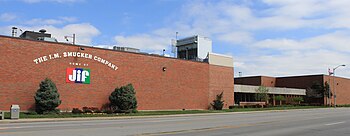
With its abundance of government and technology jobs, Lexington has one of the nation's most stable economies. Lexington has been described as having "a fortified economy, strong in manufacturing, technology and entrepreneurial support, benefiting from a diverse, balanced business base".[28] The Lexington Metro Area had a July 2008 unemployment rate of only 5.4%.[29] Lexington was named the 4th best city for "Businesses and Careers" in 2011 by Forbes Magazine,[30] the 5th best city for Young Professionals in 2008 and 6th Best Value Cities 2011 by Kiplinger.[31] As such, the city is home to several large corporations. The city has sizable employment from four Fortune 500 companies: Xerox (who acquired Affiliated Computer Services), Lexmark International, Lockheed-Martin, and IBM employing 3,000, 2,800, 1,705, and 552 respectively.[32] United Parcel Service, Trane, and Amazon.com, Inc. have a large presence in the city, and Toyota Motor Manufacturing Kentucky is within the Lexington CSA in adjoining Georgetown. The city is also host to a Jif peanut butter plant that produces more peanut butter than any other factory in the world[33] and three notable corporate headquarters: Fazoli's,[34] a fast food Italian chain that has expanded to more than twenty states; Tempur-Pedic, International, a manufacturer of mattresses with memory foam; and the Forcht Group of Kentucky, a holding company that employs more than 2,100 people across Kentucky. Forcht Group operates several businesses in Lexington including First Corbin Bancorp, Kentucky National Insurance Company, My Favorite Things, BSC, a bank data services company, and First Lab, among others.
The city's largest employer, the University of Kentucky, as of 2012, employs about 14,000, although that number is expected to shrink due to reduced funding from the state.[35] The University is the ninth largest economic company in the state of Kentucky, with an annual budget of $1.4 billion, and the College of Medicine within the University is the 21st-largest company in the state.
Other sizable employers include the Lexington-Fayette County government and other hospital facilities. This includes the Fayette County Public Schools, employing 5,374, and the Lexington-Fayette Urban County Government, employing 2,699. Central Baptist Hospital, Saint Joseph Hospital, Saint Joseph East, and the Veterans Administration Hospital employ 7,000 total.[32]
Culture
Annual cultural events and fairs
Lexington is home to many thriving arts organizations including a professional orchestra, two ballet companies, professional theatre, several museums, several choral organizations and a highly respected opera program at the University of Kentucky. In addition, there are several events and fairs that draw people from throughout the Bluegrass.

Mayfest Arts Fair is a free outdoor festival that takes place annually over Mother's Day weekend. Held in Gratz Park between the Carnegie Center and Transylvania University, the festival typically features up to 100 art and craft booths, live entertainment throughout the weekend, food, children's activities, adult activities and literary events, free carriage rides, a traditional Morris and Maypole dance and various demonstrations.
June has two popular music festivals: bluegrass and broadway. The Festival of the Bluegrass, Kentucky's oldest bluegrass music festival, is held the first full weekend in June; it includes three stages for music and a "bluegrass music camp" for school children. During the 2nd and 3rd weekends, UK Opera Theatre presents a Broadway medley "It's A Grand Night for Singing!", now over two decades old.[36]
Later in June, the Gay and Lesbian Services Organization hosts the Lexington Pride Festival, which celebrates pride in the lesbian, gay, bisexual, and transgender communities and welcomes allies. The festival offers live music, crafts, food, and informational booths from diverse service organizations. Lexington Mayor Jim Gray proclaimed June 29, 2013 as Pride Day. Lexington has one of the highest concentrations of gay and lesbian couples in the United States for a city its size.[37]
Lexingtonians gather downtown for the Fourth of July festivities which extend for several days. On July 3, the Gratz Park Historic District is transformed into an outdoor music hall when the Patriotic Music Concert is held on the steps of Morrison Hall at Transylvania University. The Lexington Singers and the Lexington Philharmonic Orchestra perform at this event. On the Fourth, annual festivities include a reading of the Declaration of Independence on the steps of the Old Courthouse, a waiter's race in Phoenix Park, a parade, a country music concert, street vendors for wares and food, and fireworks. The Fourth of July may be the biggest holiday in Lexington.
The Woodland Arts Fair, almost four decades old,[38] is held in mid-August by The Lexington Art League. It features many local and national artists working in a variety of media; vendors also sell refreshments for hungry and thirsty attendees.
“Many Cultures... One City” Festival Latino de Lexington, the biggest fiesta in September, now on its 12th year, has been the city's main event to celebrate Hispanic Heritage Month. During the festival, thousands of people, Hispanics and non-Hispanics alike, gather in downtown Lexington to enjoy the cultural displays, dancing presentations, live music, and a variety of food from different regions in Latin America.
Also in September, the Roots & Heritage Festival includes art exhibits, literary readings, film presentations, the Festival Ball and the ever-popular two-day street festival featuring live musical performances from internationally renowned artists.

"Southern Lights: Spectacular Sights on Holiday Nights",[39] taking place from November 18 to December 31, is held at the Kentucky Horse Park. It includes a three-mile (5 km) drive through the park, showcasing numerous displays, many in character with the horse industry and history of Lexington. The "Mini-Train Express", an indoor petting exotic animal petting zoo, the International Museum of the Horse, an exhibit showcasing the Bluegrass Railway Club's model train, and Santa Claus are other major highlights.
In 2002, Lexington became the first city to launch a Thriller video reenactment as a Halloween festivity. The video’s storyline and dance sequences are faithfully recreated, beginning outside the historic Kentucky Theatre and featuring hundreds of zombies who attend rehearsals at nearby Mecca Live Studio in the weeks leading up to the parade.
The Lexington Christmas Parade: Held usually the day after Thanksgiving, the parade route follows Main Street between Midland and Broadway. Festivities include a Holiday Market with over 25 arts and craft vendors, a stage with entertainment, food, and the annual tree lighting ceremony, which occur in Triangle Park.
Other events and fairs include:
- The Artists Market: A small display of arts and craft booths which is set up concurrently with the Farmer's Market each Saturday from the first weekend in June through the last weekend in August. Located in Cheapside Park adjacent to the Lexington Farmer's Market.
- Thursday Night Live: An annual summer series of free, public concerts held in Cheapside Park every Thursday evening from 4:30pm – 7:30pm in from May – October.
- A Midsummer Night's Run: A 5K race in early August.
- The Lexington Philharmonic Orchestra presents several annual concerts.[40]
- The Kentucky Women Writers Conference which has hosted dozens of the nations foremost women writers.
- Gallery Hop: a seasonal event where the city's art galleries are open to the public on the third Friday of February, April, June, September and November.
- Beaux Arts Ball: A masquerade ball hosted by the University of Kentucky's College of Design (formerly College of Architecture).
- Tournament of Champions: One of three national high school debate championship tournaments featuring policy debate and Lincoln-Douglas debate. The best teams in the nation meet after qualifying during the regular season on the first weekend in May annually, hosted by the University of Kentucky Debate Team.
Historical structures and museums
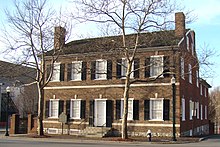
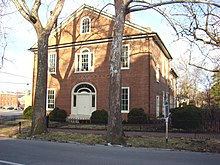
Lexington is home to numerous museums and historical structures. One of the most famous is Ashland: The Henry Clay Estate along Richmond Road east of downtown. This two-story museum is a National Historic Landmark and was the former home of statesman Henry Clay.
Lexington has demolished hundreds of historic structures, over the past few decades to make way for hotels, banks and parking structures. The Lexington Public Library was constructed where the historic Phoenix Hotel once stood. In the past decade, an entire historic 1880s block, located on Main Street was demolished. The vacant lot presently sits in the center of Lexington.
In the Phoenix Park area near the geographic center of Lexington, the world's largest ceiling clock exists; it's a five-story Foucault pendulum located in the public library. The Public Library is also home to an art gallery and the 138-seat Farish Theater. In addition to the Central Library, there are five branches located throughout the city: Beaumont (off Harrodsburg Rd.), Eagle Creek (off Richmond Rd.), Northside (Russell Cave Rd.), Tates Creek (off Tates Creek Rd.), and Village (Versailles Rd.). Lexington Public Library offers a variety of programs and services to the citizens of Fayette County and circulates nearly 3,000,000 items per year.
The Pope Villa, built in 1811, is one of the best surviving domestic designs by the architect Benjamin Henry Latrobe. It is being restored by the Bluegrass Trust for Historic Preservation, which also maintains and administers the Hunt-Morgan House.
Additional historic sites are the following:
- Aviation Museum of Kentucky
- First African Baptist Church
- The Headley-Whitney Museum
- Hunt-Morgan House
- Kentucky Theatre
- Lexington Cemetery
- Martin Castle Also known as Castle Post
- Mary Todd Lincoln House
- Old Morrison, on the Transylvania University campus
- Rupp Arena
- Waveland State Historic Site
The University of Kentucky Art Museum is the premier art museum for Lexington and the only accredited museum in the region. Its collection of over 4000 objects ranges from Old Masters to Contemporary, and it also hosts ongoing special exhibitions.[41]
The local Woolworth's building was listed on the National Register of Historic Places for its significance as a site of civil rights protests against segregation during the 1960s. The building was demolished by its owner in 2004 and the area paved for use as a parking lot until further development.[42]
Sports
College athletics

The Kentucky Wildcats, the athletic program of the University of Kentucky, is by far Lexington's most popular sports entity. The school fields 22 varsity sports teams, most of which compete in the Southeastern Conference. The most famous team by far is the men's basketball team, which has won 8 NCAA championships and is the winningest program in college basketball history, being the first to reach 2000 wins.[43] Lexington's only other collegiate team, the Transylvania University Pioneers, competes in NCAA Division III athletics.
Lexington produced a number a major collegiate and professional athletes. The more well known include World Athletics Championships multiple gold medal-winning sprinter Tyson Gay; former Tates Creek High School and Louisville Cardinals kicker David Akers, who is the all-time scoring leader for the Philadelphia Eagles; former Louisville Cardinals football player and Cleveland Browns cornerback Frank Minnifield; Miami Marlins outfielder Austin Kearns; former Kentucky and Pittsburgh Steelers center Dermontti Dawson; Current Minor league Third basemen for the Colorado Rockies Jayson Langfels. Jayson attended Lafayette High School and was an all OVC baseball player in college; Current MLB pitcher for the Arizona Diamondbacks Chas Roe who was drafted out of high school by the Seattle Mariners; Current MLB pitcher Robby Ross who was drafted by the Texas Rangers and attended Lexington Christian Academy; Current outfielder for the Philadelphia Phillies, Ben Revere attended Lexington Catholic High School and got drafted by the Minnesota Twins out of high school; and NBC Sports announcer Tom Hammond.
Professional sports
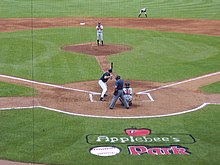
Lexington is home to the Lexington Legends, a Class A minor league affiliate of the Kansas City Royals. Since its inception in 2001, Lexington has produced numerous major leaguers including: 2009 National League All-Star Hunter Pence (Outfielder), John Buck (Catcher), Mike Gallo (Pitcher), and Josh Anderson, (Right fielder). The Legends belong to the South Atlantic League, have one league title (2001) and four playoff appearances since 2001. Roger Clemens pitched in one game for the Legends in 2006 as part of his preparation to return to the Houston Astros.
The University of Kentucky Hockey team competes at club level in the American Collegiate Hockey Association.[44]
Horse racing and equestrian events
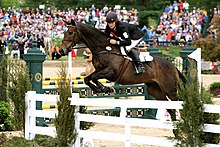
Lexington has been known as a major center for Thoroughbred breeding since the late 18th century due to the high calcium content in the soils of the Inner Bluegrass Region, which leads to stronger bones and greater durability in horses.
The city is home to two horse racing tracks, Keeneland and the The Red Mile harness track. Keeneland, sporting live races in April and October, is steeped in tradition; little has changed since the track's opening in 1936. The Red Mile Harness Track is the oldest horse racing track in the city and the second oldest in the nation. There you can see horses pull two-wheeled carts called sulkies while racing, also known as harness racing.
The Kentucky Horse Park, located along scenic Iron Works Pike in northern Fayette County, is a comparative late-comer to Lexington, opening in 1978. Although commonly known as a tourist attraction and museum, it is also a museum and working horse farm with a farrier and famous retired horses such as Cigar and 2003 Kentucky Derby winner Funny Cide. Since its opening in April 1978, the Kentucky Horse Park has hosted the Rolex Kentucky Three Day Event, which is one of the top 3 annual equestrian eventing competitions in the world and held immediately before the Kentucky Derby at Churchill Downs in Louisville. In September and October 2010, Lexington hosted the World Equestrian Games,[45] the first time the games were held outside of Europe. Since October/November 2011, the Kentucky Horse Park has hosted the National Horse Show.
Parks and outdoor attractions
City parks and facilities
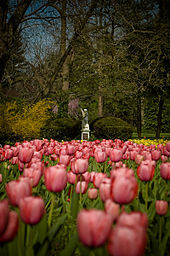
Lexington has over 100 parks ranging in size from the 8,719-square-foot (810.0 m2) Smith Street Park to the 659-acre (2.7 km2) Masterson Station Park.[46][47] Among those parks are:
- six public golf courses at Avon, Kearney Links, Lakeside, Meadowbrook, Tates Creek and Picadome
- four dog parks at Jacobson, Masterson Station, Coldstream, and Wellington.
- two public 18-hole disc golf courses at Shillito Park and at Veterans Park
- a public skate park at Woodland Park, featuring 12,000 square feet (1,100 m2) of "ramps, platforms, bowls, and pipes".[46]
For the Kentucky Horse Park, see Sporting Events below.
Natural areas
The city is home to Raven Run Nature Sanctuary, a 734-acre (3.0 km2) nature preserve along the Kentucky River Palisades.[46][48] There are 11 miles (18 km) of back-country hiking trails that range from wheelchair-accessible paved trails to difficult single-track trails. It is common to run across hopeful Appalachian Trail backpackers. The city has recently purchased land adjacent to the park which will make Raven Run the largest park in the city. Raven Run is home to over 56 species of trees, 600 species of plants, 200 species of birds, and other wildlife. Remains of a grist mill, homestead and limekiln remain. The preserve also has a nature center and various educational programs throughout the year. Such programs include seasonal wildflower walks, stargazing during the warmer months, evening insect tours, and historical walks and presentations.
The Arboretum is a 100-acre (0.40 km2) preserve adjacent to the University of Kentucky.[46] It features the Arboretum Woods, a small, 16-acre (65,000 m2) Bluegrass Woodland patch that is home to eighteen native Kentucky tree species, and more than 50 native Kentucky grasses and herbs. It also has 1,500 varieties of roses in the Rose Garden, a Home Demonstration Garden, and numerous paved paths and trails.
The city also plays host to the historic McConnell Springs, a 26-acre (110,000 m2) park within the industrial confines off of Old Frankfort Pike.[46][48] There are two miles (3 km) of trails that surround the namesake springs, historic dry-laid stone fences, and historical structures.
Government and politics
Federally, Lexington is part of Kentucky's 6th congressional district, represented by Republican Andy Barr, elected in 2012. Previously, Democrat Ben Chandler represented Lexington, elected in 2004.
The state's senior member of the United States Senate is the Republican Floor Leader, Mitch McConnell, elected in 1984. The state's junior member of the United States Senate is Rand Paul, elected in 2010. The Governor of Kentucky is Democrat Steve Beshear, elected in 2007.
In 1974, the governments of the city of Lexington and Fayette County, Kentucky, combined to create the current Lexington-Fayette Urban County Government, often abbreviated LFUCG. Lexington has an elected mayor and city council-style of government.
Mayor
On November 2, 2010, former vice-mayor Jim Gray was elected mayor, becoming the city's first openly gay mayor.[49] He was sworn into office on January 2, 2011, by Kentucky Supreme Court justice Mary Noble.[49] Gray was preceded by Mayor Jim Newberry,[49] and the two collaborated on developing improved industrial and agricultural opportunity for the City of Lexington and the State of Kentucky.
Urban County Council
The Urban County Council is a 15-member legislative group. Twelve of the members represent specific districts and serve two-year terms; three are elected city-wide as at-large council members and serve four-year terms. The at-large member receiving the highest number of votes in the general election automatically becomes the Vice Mayor who, in the absence of the Mayor, is the presiding officer of the Council. The current council members as of 2013 are:[50]
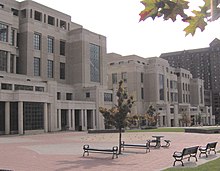
| Councilor | District | Term Ends |
|---|---|---|
| Linda Gorton | Vice Mayor | 2014 |
| Chuck Ellinger II | At-Large | 2014 |
| Steve Kay | At-Large | 2014 |
| Chris Ford | 1st | 2014 |
| Shevawn Akers | 2nd | 2014 |
| Diane Lawless | 3rd | 2014 |
| Julian Beard | 4th | 2014 |
| Bill Farmer, Jr. | 5th | 2014 |
| Kevin Stinett | 6th | 2014 |
| Jennifer Scutchfield | 7th | 2014 |
| George Myers | 8th | 2014 |
| Jennifer Mossotti | 9th | 2014 |
| Harry Clarke | 10th | 2014 |
| Peggy Henson | 11th | 2014 |
| Ed Lane | 12th | 2014 |
Law enforcement
Primary law enforcement duties within Lexington are the responsibility of the Lexington-Fayette Urban County Government Division of Police. The Division of Police resulted from the merger of the Lexington Police Department with the Fayette County Patrol in 1974. The Fayette County Sheriff's Office is responsible for court service, including court security, prisoner transport, process and warrant service, and property tax collection. The University of Kentucky Police Department, the Transylvania University Department of Public Safety, Blue Grass Airport Public Safety, Lexington-Fayette Division of Community Corrections, Fayette County Schools Department of Law Enforcement, the Veterans Affairs Police Department and the Kentucky Horse Park Police also have jurisdiction within their geographic areas in Lexington-Fayette County. In addition, the Lexington-Fayette Animal Care & Control exercises law enforcement over animal control issues and the Kentucky State Police, KSP Division of Commercial Vehicle Enforcement and Kentucky Department of Fish and Wildlife Resources can be seen performing their respective law enforcement duties within the county. Several federal law enforcement agencies, such as the FBI and Secret Service, maintain satellite offices within Lexington while the Federal Bureau of Prisons operates FMC Lexington within Fayette County.
Education

According to the United States Census, of Lexington's population over the age of twenty-five, 22.4% hold a bachelor's degree, 11.4% hold a master's degree, and 3.1% hold a professional degree. Just 2.6% hold a doctorate degree. Lexington was ranked 10th in a list of America's most educated cities with a population of more than 250,000, ranked by percentage of bachelor's degrees among residents 25 and older, according to the United States Census Bureau.[51] In a report released by Jack Miller, president of Central Connecticut State University, Lexington ranks 13th in the United States in terms of literacy rate.[52] The index was compiled through six indicators of literacy, including Internet sources, newspaper circulation, the number of bookstores, library resources, education and periodical resources.
The city is served by the Fayette County Public Schools. The system consists of 5 high schools, 12 middle schools, and 35 elementary schools, along with six private schools. There are also two traditional colleges: the University of Kentucky, which is the state's flagship public university, and Transylvania University, which is the state's oldest four-year university. Other institutions of higher learning include Bluegrass Community and Technical College, Sullivan University, Spencerian College, Medtech College, Strayer University, Commonwealth Baptist College, and a newly opened distance-learning extension of Indiana Wesleyan University. Additionally, Kentucky State University, Eastern Kentucky University and Berea College are in the neighboring cities of Frankfort, Richmond and Berea respectively, which places them within the Lexington Combined Statistical Area.
Media
Lexington's largest daily circulating newspaper is the Lexington Herald-Leader. The region is also served by eight primary television stations, including WLEX, WKYT, WDKY, WTVQ, The CW, WKLE, and MyNetworkTV, and online news agency KyForward.com. Business Lexington is a bi-weekly business newspaper. The Chevy Chaser Magazine and the Southsider Magazine are two community publications. The state's public television network, Kentucky Educational Television (KET), is headquartered in Lexington and is one of the nation's largest public networks.
Transportation
Highways
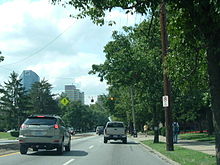
The northeast border of Lexington has direct access to Interstate 64 and Interstate 75, but freeways do not run through downtown or other sections of the city. Instead, Lexington has two beltways: inner New Circle Road (KY 4) and outer Man o' War Boulevard (southern semi-circle), then numerous arterial highways/U.S. routes radiate from downtown to the surrounding suburbs and small towns.
Lexington suffers considerable traffic congestion for a city of its size due to the lack of freeways, the proximity of the University of Kentucky to downtown, and the substantial number of commuters from outlying towns. For traffic relief on northern New Circle Road, Citation Boulevard is planned[53] to connect Leestown Road and Russell Cave Road. Other proposed projects include widening/closing certain roads and changing directions from one-way to two-way.
Air
Blue Grass Airport is Lexington's primary commercial airport. It provides approximately 13 nonstop flights and a total of 86 flights daily from its two runways. Five major airlines operate connection service at Blue Grass, including Allegiant Air, American Eagle, Delta Air Lines, United Express, and US Airways Express.
On August 27, 2006, Comair Flight 5191 took off from the wrong runway, and crashed in a nearby field, killing 49 of the 50 passengers, leaving the first officer alive but badly burned. The aircraft involved was a 50-seat Bombardier Canadair Regional Jet CRJ-100ER, serial number 7472. On August 27, 2011, a memorial sculpture depicting 47 steel birds flying was unveiled and dedicated to the victims.
The airport is located four miles (six km) west of the city center, at the intersection of US 60 (Versailles Road) and Man o' War Boulevard.
In addition to commercial airline service, the airport is also home to several private {general aviation} operators including TACAir, which serves as the airport's FBO (Fixed Base Operator). Flight training and aircraft maintenance services are also offered. A brand new general aviation runway was dedicated August 4, 2010.
Public transportation
Lexington is served by LexTran, a public transit bus agency operated by LFUCG and has been in existence since 1972. LexTran (officially the Transit Authority of the Lexington-Fayette Urban County Government) is a public transportation bus system serving Lexington, Kentucky. It runs bus routes throughout the city which all converge in downtown at the Lexington Transit Center located at 220 East Vine. It provides public transportation in the form of buses and lift vans. It operates seven days a week on eight bus routes from 5:30 a.m. to 12:30 a.m. In addition to mainline and paratransit, LexTran contracts with the University of Kentucky and operates four routes around the campus. It also runs two routes to the Bluegrass Community and Technical College campuses. Even though Lexington and Fayette County are a consolidated government, LexTran does not provide service outside the Lexington city proper due to limited funding sources.
Transportation planning
The Lexington Area Metropolitan Planning Organization is responsible for transportation planning for Fayette and Jessamine Counties. This includes activities such as carpool matching, administering a commuter vanpool program, air quality forecasting, bicycle and pedestrian planning, congestion management, and developing transportation plans and documents.
Notable people
Sister cities
Lexington has four sister cities, as designated by Sister Cities International:
 Deauville, France since 1957
Deauville, France since 1957 County Kildare, Ireland since 1984
County Kildare, Ireland since 1984 Newmarket, United Kingdom since 2003
Newmarket, United Kingdom since 2003 Shinhidaka, Japan since 2006
Shinhidaka, Japan since 2006
- Shinhidaka was formed by a 2006 local government merger. One of the entities involved in the merger was Shizunai, which established a sister city relationship with Lexington in 1988.
All four are, like Lexington, major centers of the Thoroughbred breeding industry in their respective countries.
See also
References
- ^ a b c Commonwealth of Kentucky. Office of the Secretary of State. Land Office. "Lexington, Kentucky". Accessed 18 September 2013.
- ^ http://factfinder2.census.gov/faces/tableservices/jsf/pages/productview.xhtml?src=bkmk
- ^ "Degrees & Training – Most-Educated Cities in the United States". Retrieved 15 February 2011.
- ^ Ramsay, Robert L. (1952). Our Storehouse of Missouri Place Names. University of Missouri Press. p. 16.
- ^ a b "First African Baptist Church", Lexington: The Athens of the West, National Park Service. Retrieved 21 August 2010.
- ^ George Washington Ranck, ''The Traveling Church: An Account of the Baptist Exodus from Virginia to Kentucky in 1781 under the Leadership of Rev. Lewis Craig and Capt. William Ellis'', Louisville, KY: 1910, p. 22, accessed 21 Aug 2010. Books.google.com. 2009-01-27. Retrieved 2011-11-18.
- ^ "Christ Church Episcopal", Lexington, National Park Service. Retrieved 21 August 2010.
- ^ a b H. E. Nutter, A Brief History of the First Baptist Church (Black) Lexington, Kentucky, 1940, accessed 22 Aug 2010
- ^ "History of the Addiction Research Center". Drugabuse.gov. 1935-05-15. Retrieved 2011-11-18.
- ^ Athens of the West; Lexington, Kentucky: The Athens of the West - A National Register of Historic Places Travel Itinerary; National Park Service; 2009
- ^ "Fayette County". QuickFacts from the US Census Bureau. Retrieved 2010-12-29.
- ^ Malone, Robert. "In Pictures: The World's Cleanest Cities". Forbes. Retrieved 6 April 2010.
- ^ a b c "Greenbrier Small Area Plan" (PDF) (Press release). Lexington-Fayette Urban County, Kentucky. 2003-04-17. Retrieved 2007-05-20.
- ^ a b c d "Planning History" (Press release). Lexington-Fayette Urban County, Kentucky. Retrieved 2007-05-20.
- ^ How Stuff Works map of American climate zones. Retrieved on 31 January 2010
- ^ "Information About Asthma, Allergies, Food Allergies and More!". Asthma and Allergy Foundation of America. Retrieved 2010-12-29.
- ^ "NowData - NOAA Online Weather Data". National Oceanic and Atmospheric Administration. Retrieved 2012-02-15.
- ^ "Monthly Averages for Lexington, KY (40505)". The Weather Channel. Retrieved 2012-02-15.
- ^ Annual Estimates of the Resident Population: April 1, 2010 to July 1, 2013 Population Estimates U.S. Census Bureau. Retrieved 2014-04-23
- ^ "Table 1. Annual Estimates of the Population of Metropolitan and Micropolitan Statistical Areas: April 1, 2010 to July 1, 2013" (CSV). 2013 Population Estimates. United States Census Bureau, Population Division. April 2014. Retrieved 2014-04-23.
- ^ a b "Table 2. Annual Estimates of the Population of Combined Statistical Areas: April 1, 2010 to July 1, 2012" (CSV). 2012 Population Estimates. United States Census Bureau, Population Division. March 2013. Retrieved 2013-06-06. Cite error: The named reference "PopEstCSA" was defined multiple times with different content (see the help page).
- ^ Hillery Jr., George A. (1966). Population Growth in Kentucky, 1820–1960. University of Kentucky Agriculture Experiment Station.
- ^ 1970 Census of the Population, Volume 1: Characteristics of the Population, Part 19, Kentucky. United States Government Printing Office. 1973.
- ^ 1980 Census of the Population, Volume 1: Characteristics of the Population, Part 19, Kentucky. United States Government Printing Office. 1982.
- ^ "KSDC News". Kentucky State Data Center. Spring 1997.
- ^ "Lexington-Fayette, Kentucky – Population finder". United States Census Bureau.
- ^ "Annual Estimates of the Population for Incorporated Places in Kentucky". U.S. Census Bureau. Retrieved 2007-06-28.
- ^ "A Fortified Economy" (PDF). delta-sky.com. Archived from the original (PDF) on 2012.
{{cite web}}: Check date values in:|archivedate=(help) - ^ "Steptoe & Johnson - Steptoe & Johnson's Lexington Office". Steptoe-johnson.com. Retrieved 2011-11-18.
- ^ Winterbottom, Dane (April 24, 2012). "Forbes' Best Places For Business And Careers Lexington, KY #4!". Retrieved 24 April 2012.
- ^ "Kiplinger slide shows". kiplinger.com. Retrieved 28 November 2010.
- ^ a b "Major Employers". Commerce Lexington. Retrieved July 16, 2013.
- ^ "Fun Tidbits". The J.M. Smucker Co. Archived from the original on March 28, 2010. Retrieved 2007-12-28.
- ^ "Fazoli's Company Info". fazolis.com. Retrieved 16 July 2013.
- ^ Blackford, Linda B. (June 5, 2012). "University of Kentucky begins laying off 'significant' number of employees". Lexington Herald-Leader. Retrieved July 24, 2012.
- ^ ""It's a Grand Night for Singing!" Turns 21". uknow.uky.edu. Retrieved 16 July 2013.
- ^ Mead, Andy (November 7, 2010). "Lexington to become third-largest U.S. city with an openly-gay mayor". Lexington Herald-Leader. Retrieved July 16, 2013.
- ^ "Woodland Arts Fair". lexingtonartleague.org. Retrieved 16 July 2013.
- ^ "Holiday Admission Discount Coupon". kyhorsepark.com. Retrieved 28 November 2010.
- ^ "The Lexington Philharmonic Online". Lexington, Kentucky, USA: lexphil.org.
- ^ "University of Kentucky Art Museum". Uky.edu. Retrieved 2011-11-18.
- ^ "Downtown Lexington's Next Loss: Woolworth's". Preservation Magazine. August 2004. Retrieved 2009-03-07.
{{cite journal}}: Cite journal requires|journal=(help) - ^ "'Uk2k' shirt a surprise winner". December 23, 2009. Retrieved September 13, 2010. Herald-Leader [Lexington]
- ^ University of Kentucky Hockey
- ^ "2010 Alltech FEI World Equestrian Games". Retrieved July 24, 2012.
- ^ a b c d e Fun Guide 2007. City of Lexington, Kentucky, Division of Parks and Recreation. 2007.
- ^ "Parks – Lexington-Fayette Urban County Government".
- ^ a b "Parks – Lexington-Fayette Urban County Government". Retrieved 31 August 2006.
- ^ a b c Fortune, Beverly (January 3, 2011). "Gray, Gorton inaugurated as Lexington mayor, vice mayor". Lexington Herald-Leader. Retrieved July 24, 2012.
- ^ Urban County Council Members Lexington-Fayette Urban County Government. Retrieved 2013-08-05
- ^ Christie, Les (31 August 2006). "America's smartest cities". CNN. Retrieved 2006-09-02.
- ^ "Lexington Ranks As 17th Most Literate City". WKYT-TV. 12 December 2007. Retrieved 2007-12-28.
- ^ Aretakis, Rachel (August 7, 2013). "Citation Boulevard extension begins". Herald-Leader. Retrieved July 7, 2013.
Further reading
- Gelbert, Doug. A Walking Tour of Lexington, Kentucky (2011) excerpt and text search
- Leet, Karen M. et al. Civil War Lexington, KY: Bluegrass Breeding Ground of Power (2011) excerpt and text search
- Smith, Gerald L. Lexington Kentucky (KY) (Black America) (2002)
- Wright, John D., Jr. Lexington: Heart of the Bluegrass (1994); 244pp; a history
- Jillson, Willard Rouse (October 1929). "The Founding of Lexington, Kentucky". Filson Club Historical Quarterly. 3 (5). Retrieved 2011-11-29.
- Hollingsworth, Randolph (2004). Lexington: Queen of the Bluegrass. Charleston, SC: Arcadia Press. ISBN 9780738524665.
- Klotter, James C. (2012). Bluegrass Renaissance: The History and Culture of Central Kentucky, 1792-1852. Lexington, KY: University Press of Kentucky. ISBN 9780813136073.
{{cite book}}: Unknown parameter|coauthor=ignored (|author=suggested) (help) (emphasis on the architect Benjamin Henry Latrobe and "neoclassical" Lexington) - Wilson, Samuel M. (January 1930). "Date of the First Settlement of Lexington, Kentucky". Filson Club Historical Quarterly. 4 (1). Retrieved 2011-11-29.
External links
- Official website of Lexington, Kentucky
- Official website of Downtown Lexington Corporation
- Official website of the Lexington Convention and Visitors Bureau
- Lexington Kentucky: The Athens of the West, a National Park Service Discover Our Shared Heritage Travel Itinerary
- Downloadable PDF and Plain text versions of George Washington Ranck's 1872 book, History of Lexington, Kentucky





